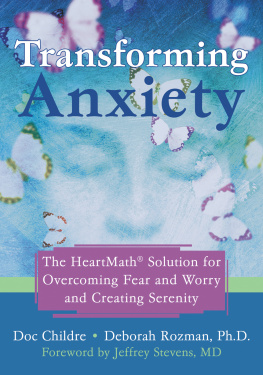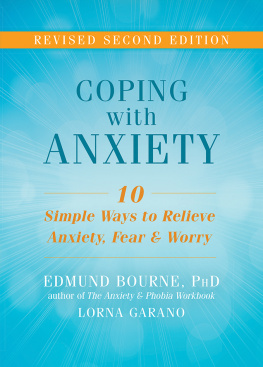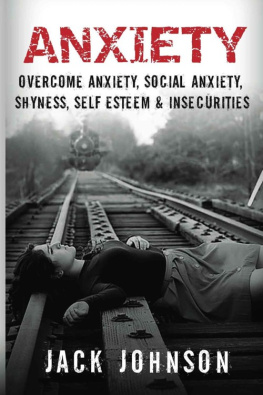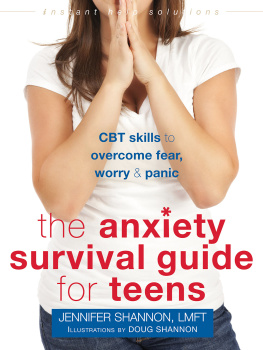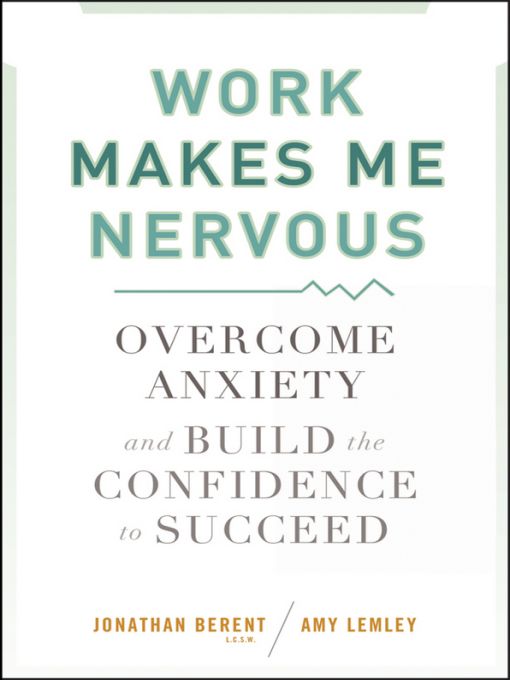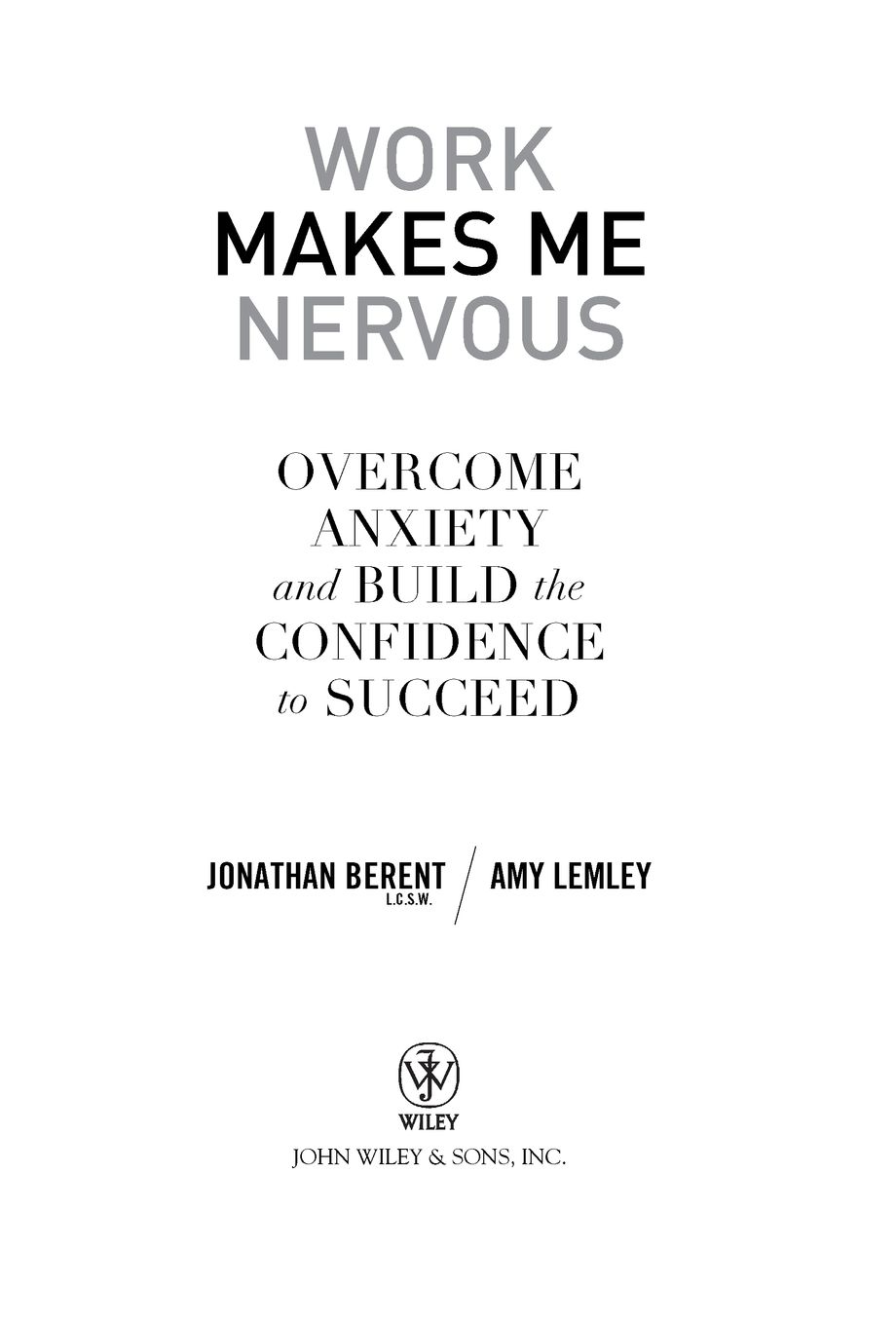Table of Contents
For Barbara, Momo, and the creative pursuit of family
Jonathan Berent
For Robert Emery and Mary Shemo, with gratitude
Amy Lemley
PREFACE
The Truth from Two Perspectives
Destiny. Kismet. Beshert. Throughout the worlds cultures, there are words to describe the notion of fatesomething that was simply meant to be. Our chance meeting on a community basketball court 20 years ago led to our writing this book togetherone of us a psychotherapist and one of us a person who suffers from anxiety and avoidance. These two perspectives combine in a unique way to present the full spectrum of affliction and recovery. That is our commitment to this projectand our commitment to our readers.
Jonathan Berent, L.C.S.W., and Amy Lemley
Ten Thousand Voices
In 1976, fresh out of graduate school in psychology, I was working as a youth counselor in a community center. An associate of mine had an idea: Establish a socialization program for teenagers with learning disabilities. A socialization program? Learning disabilities? I had no idea what she was talking about. Nevertheless, we embarked on this endeavor. I would interview applicants prior to their starting the program. A high percentage of the teenagers would not come to the group after the initial interview. What was this about? This was fate introducing me to social anxiety a long time before the term gained widespread attention. Shortly after I held this position, I started my own psychotherapy practice. From the beginning, I was working with stress-related disorders and biofeedback. This evolved into the specialty of social anxiety and performance anxiety and related issues.
Since 1977, I have treated approximately 10,000 people of all ages in individual, group, and family therapy. My clients with workplace anxiety have included C-suite executives, middle managers, and entry-level employees, bankers, salespeople, engineers, entrepreneurs, teachers, principals, professors, performers, scientists, artists, athletesand more. As for results, I have seen it all, from a total cure to the problem being permanent and everything in between. I have served as a stress management consultant to numerous corporations and organizations including NBC, United Federation of Teachers, Technicon Science Center, Bloomingdales, and Bankers Trust. I have worked with special needs groups also and have established a number of socialization programs for them. In addition, in 1988, I was feeling compelled to educate the community about the little-known problem of social anxiety and I embarked on a public relations campaign. Since that time, I have done more than 1,500 radio and television shows, from Oprah to Opie & Anthony. I have experienced my own dramatic learning curve with performance issueson the front line.
My work as a psychotherapist began on a different kind of front line. I started graduate school in clinical social work in 1973. All the classes were conducted in a circle discussion group. I was new to the field of psychotherapy and experienced substantial intimidation. I worried about what I would say in class. What would the others think of me? This was not an anxiety disorder, however, but a lack of confidence.
Internships are an integral part of the graduate educational experience. My first placement was rather benign, a community center. For my second, I asked for, and received, placement as a counselor in a correctional institution. At this time in my life, I was somewhat navesome of my primary motivators were exploration and creativity. Later in this book, you will learn about this aspect of the personality as the natural child mind state, which can be a wonderful, inspiring, and freeing part of yourself when correctly balanced with the other mind states you will learn about.
I had no idea what I was getting into. I found myself working in a halfway house in the Bronx, New York. My clientele consisted of adolescents who had committed serious crimes. There were 12 kids in this halfway house50 percent of whom were there for homicide. All the residents were black or Hispanic.
I was able to develop a few relationships with clients because there was a basketball court across the street. It was a pretty wild scene, playing in this drug-infested playground. There was a pool table in the basement of the house, around which we had some interesting conversations. I recall one 16-year-old saying matter-of-factly, I feel sorry for that womanthat woman being the victim he had shot in the head and killed. At one point, one of the clients went AWOL and returned with a gun, intending to kill the resident social worker. It was then that my university took me out of this placement. I finished my internship in an elementary school in Brooklyn.
The halfway house internship was a tremendous learning opportunity for mea multimillion-dollar educational experience, in my viewbecause nothing that I would ever do professionally could be as scary. I do remember feeling some anxiety at night at home, sometimes saying to myself, I cant believe I have to go there tomorrow! In addition to learning that rehabilitation with this clientele was a near impossibility, I also learned that anxiety is a relative phenomenon. The more I dealt with it, the easier it became to deal with. This was true for me, and I could see that it was true for others as well. At some point I began to realize, almost unconsciously, that my professional destiny was to work with anxiety.
What dramatic irony that I met Amy Lemleya gifted writer with anxiety and avoidant personality! We wrote our first book together in 1992: Beyond Shyness: How to Conquer Social Anxieties. Almost 20 years later, we are working together again on a topic about which both of us are experts, though from different perspectives.
I met Amy in 1988 in East Hampton, New York. Her thenboyfriend, who also happened to be a writer, and I were involved in a regular basketball game. He introduced me to Amy, who was working as a freelance journalist and editor, and soon we were collaborating on our first book. Amy is a seasoned professional with 26 years of experience in all facets of writingbooks, magazine and newspaper articles, plus columns, newsletters, Web sites, and marketing and advertising. Most people who know her do not realize that she has suffered from a little understood but extremely pervasive, almost epidemic, problem called avoidant personality disorder. This problem is caused by anxiety. Although she still confronts her natural tendency to avoid situations that might make her anxious, Amy has recovered from her addiction to avoidance (yes, addictionmore on this later in the book).
Very little is written about the avoidant personality. But in this book, as I discuss anxiety and avoidance from a clinical perspective, Amy tells her own storythe good, the bad, and the ugly along with the triumphs that have made her a success. She summarizes her experiences in the following section of this Preface. I see Amy as a role model for those who say what she says: Work makes me nervous.
Jonathan Berent, L.C.S.W.
East Hampton, New York
A Life in Hiding
I have spent most of my life feeling like a fraud. If people really knew me, I believed, they would think so little of me that I would face rejection constantly. My public persona has almost always been that of an outgoing, vivacious, engaging, and confident person. But I hid a terrible secret: I was anxious, avoidant, selfish, and passive-aggressive. This was true even in childhood. Heres how a first grader practices avoidance: At age seven, I was already using a sixth-grade English textbook and loved doing my language arts homework each day; but I avoided doing my math workbook for months, hiding my lack of ability (and therefore interest) in that subject. When my parents found out, they kept me home for two days and made me complete months of work to catch up. I managed to do itand that may have been the first deadline rush Id ever encountered; I had gotten away with somethingavoiding my assignment, denying to myself that it mattered, and coming through in the nick of time with a selfish attitude of Ill do it my way and youre gonna like it.



